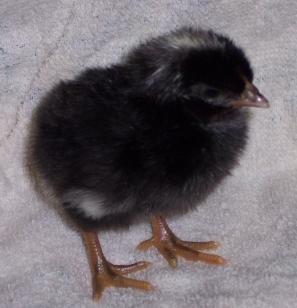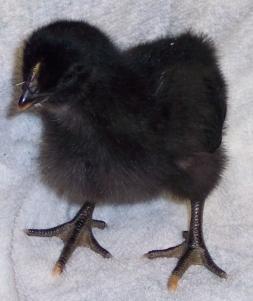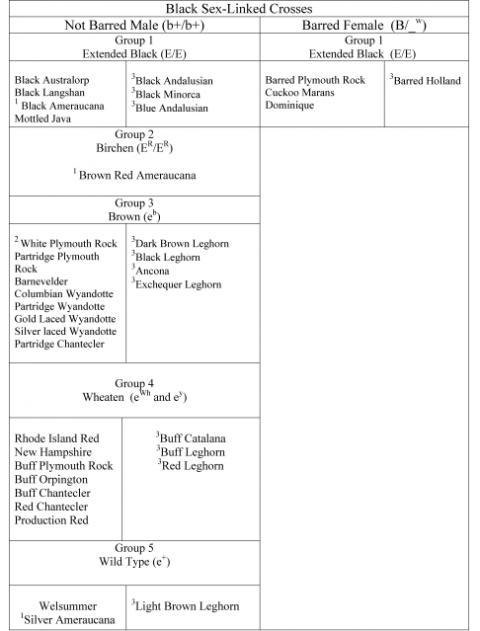I don’t think the sex links is accurate in this case. The rooster has to be a red based coloration.
Navigation
Install the app
How to install the app on iOS
Follow along with the video below to see how to install our site as a web app on your home screen.
Note: This feature may not be available in some browsers.
More options
You are using an out of date browser. It may not display this or other websites correctly.
You should upgrade or use an alternative browser.
You should upgrade or use an alternative browser.
Golden Cuckoo Maran X Blue Ameraucana Roo
- Thread starter atm21
- Start date
Correct.
If you want to read more about sex links the first post in this thread is helpful
https://www.backyardchickens.com/threads/sex-linked-information.261208/
From that thread:
Black Sex-linked
There are two important genes that must be a part of a black sex-linked cross; the E locus allele called extended black (E) and the sex-linked barring gene (B). The Barred Plymouth rock carries both E and B and both genes are used as the female side in commercial black sex linked crosses while the male side of the cross is a Rhode Island Red or a New Hampshire. Birchen birds at times can be used in black sex linked crosses. It is best to leave the use of birchen birds to individuals that have tested the birds for the correct genotype. If birchen birds do not have the correct genotype, the offspring will not be black sex linked.
A few specifics to remember about a black sex-linked cross are:
1) the female must carry sex-linked barring (barred),
2) the male can not carry sex-linked barring (male can not be barred),
3) one of the birds must be homozygous for extended black or carry two extended black genes and
4) neither of the birds can carry dominant white or in other words be a white bird. Some recessive white birds may work on the male side of the cross but you never know if it will work or not work. So I suggest not using white birds.
5). Almost any variety (color) of male ( not including white or barred ) can be used in a black sex linked cross. White birds sometimes carry dominant white and or barring which would not work in a black sex linked cross. White males that do not carry dominant white or barring will work as the male in a black sex linked cross. White males like the white wyandotte or the white plymouth rock will work if they do not carry dominant white or barring.
In a black sex-linked cross, the female will only contribute the barring gene to the male offspring. So the adult males will be black and barred. The female offspring will receive their sex linked trait from the father; in this case, the recessive gene for no barring. So the females will not be barred as adults.
It is also important that the chick down has a black dorsal surface, back and top of the head; this allows for the barring gene to be expressed as a white or cream spot on top of the male chicks head. See Illustration 5. This is why a white bird that carries dominant white can not be used to produce black sex linked chicks. The top of the head would be white and the white spot will not show. Males that carry barring can not be used because the males will produce females chicks with white spots on their heads.
The top of a female chicks head will be a solid black color. See Illustration 6. The chicks in the pictures do not have a white belly like many other black sex linked chicks.
Illustration 5 male black sex-link Illustration 6 female black sex-link


Examples of breeds that can be used for black sex linked crosses.

1 Male carries the blue egg shell gene.
2 Not a good choice may carry barring.
3. Carry the genes for white egg shell.
If you want to read more about sex links the first post in this thread is helpful
https://www.backyardchickens.com/threads/sex-linked-information.261208/
From that thread:
Black Sex-linked
There are two important genes that must be a part of a black sex-linked cross; the E locus allele called extended black (E) and the sex-linked barring gene (B). The Barred Plymouth rock carries both E and B and both genes are used as the female side in commercial black sex linked crosses while the male side of the cross is a Rhode Island Red or a New Hampshire. Birchen birds at times can be used in black sex linked crosses. It is best to leave the use of birchen birds to individuals that have tested the birds for the correct genotype. If birchen birds do not have the correct genotype, the offspring will not be black sex linked.
A few specifics to remember about a black sex-linked cross are:
1) the female must carry sex-linked barring (barred),
2) the male can not carry sex-linked barring (male can not be barred),
3) one of the birds must be homozygous for extended black or carry two extended black genes and
4) neither of the birds can carry dominant white or in other words be a white bird. Some recessive white birds may work on the male side of the cross but you never know if it will work or not work. So I suggest not using white birds.
5). Almost any variety (color) of male ( not including white or barred ) can be used in a black sex linked cross. White birds sometimes carry dominant white and or barring which would not work in a black sex linked cross. White males that do not carry dominant white or barring will work as the male in a black sex linked cross. White males like the white wyandotte or the white plymouth rock will work if they do not carry dominant white or barring.
In a black sex-linked cross, the female will only contribute the barring gene to the male offspring. So the adult males will be black and barred. The female offspring will receive their sex linked trait from the father; in this case, the recessive gene for no barring. So the females will not be barred as adults.
It is also important that the chick down has a black dorsal surface, back and top of the head; this allows for the barring gene to be expressed as a white or cream spot on top of the male chicks head. See Illustration 5. This is why a white bird that carries dominant white can not be used to produce black sex linked chicks. The top of the head would be white and the white spot will not show. Males that carry barring can not be used because the males will produce females chicks with white spots on their heads.
The top of a female chicks head will be a solid black color. See Illustration 6. The chicks in the pictures do not have a white belly like many other black sex linked chicks.
Illustration 5 male black sex-link Illustration 6 female black sex-link


Examples of breeds that can be used for black sex linked crosses.

1 Male carries the blue egg shell gene.
2 Not a good choice may carry barring.
3. Carry the genes for white egg shell.
I guess I was wrong.
We might be able to sex with individual pics.
If you read keesmom’s post you’ll see that it says almost any colored male can be used and sex linked chicks will result.
He can’t be barred & he can’t be white.
If a Blue Andalusian (see chart) will work so will a Blue Ameracauna.
The barring gene itself is sex linked.
My understanding is this also works when crossing a barred male to a non-barred/non-white female.
In this cross it’s the female chicks that have the head spot because the male passes the barring gene to the opposite sex offspring.
My friend has a barred roo and solid hens and I told her all the barred chicks were females.
She was amazed but happy lol.
He can’t be barred & he can’t be white.
If a Blue Andalusian (see chart) will work so will a Blue Ameracauna.
The barring gene itself is sex linked.
My understanding is this also works when crossing a barred male to a non-barred/non-white female.
In this cross it’s the female chicks that have the head spot because the male passes the barring gene to the opposite sex offspring.
My friend has a barred roo and solid hens and I told her all the barred chicks were females.
She was amazed but happy lol.
Last edited:
Those look just like my babies I just hatched.....Correct.
If you want to read more about sex links the first post in this thread is helpful
https://www.backyardchickens.com/threads/sex-linked-information.261208/
From that thread:
Black Sex-linked
There are two important genes that must be a part of a black sex-linked cross; the E locus allele called extended black (E) and the sex-linked barring gene (B). The Barred Plymouth rock carries both E and B and both genes are used as the female side in commercial black sex linked crosses while the male side of the cross is a Rhode Island Red or a New Hampshire. Birchen birds at times can be used in black sex linked crosses. It is best to leave the use of birchen birds to individuals that have tested the birds for the correct genotype. If birchen birds do not have the correct genotype, the offspring will not be black sex linked.
A few specifics to remember about a black sex-linked cross are:
1) the female must carry sex-linked barring (barred),
2) the male can not carry sex-linked barring (male can not be barred),
3) one of the birds must be homozygous for extended black or carry two extended black genes and
4) neither of the birds can carry dominant white or in other words be a white bird. Some recessive white birds may work on the male side of the cross but you never know if it will work or not work. So I suggest not using white birds.
5). Almost any variety (color) of male ( not including white or barred ) can be used in a black sex linked cross. White birds sometimes carry dominant white and or barring which would not work in a black sex linked cross. White males that do not carry dominant white or barring will work as the male in a black sex linked cross. White males like the white wyandotte or the white plymouth rock will work if they do not carry dominant white or barring.
In a black sex-linked cross, the female will only contribute the barring gene to the male offspring. So the adult males will be black and barred. The female offspring will receive their sex linked trait from the father; in this case, the recessive gene for no barring. So the females will not be barred as adults.
It is also important that the chick down has a black dorsal surface, back and top of the head; this allows for the barring gene to be expressed as a white or cream spot on top of the male chicks head. See Illustration 5. This is why a white bird that carries dominant white can not be used to produce black sex linked chicks. The top of the head would be white and the white spot will not show. Males that carry barring can not be used because the males will produce females chicks with white spots on their heads.
The top of a female chicks head will be a solid black color. See Illustration 6. The chicks in the pictures do not have a white belly like many other black sex linked chicks.
Illustration 5 male black sex-link Illustration 6 female black sex-link


Examples of breeds that can be used for black sex linked crosses.

1 Male carries the blue egg shell gene.
2 Not a good choice may carry barring.
3. Carry the genes for white egg shell.
Unfortunately the reverse cross does not result in sex linked chicks. If the male is homozygous for barring he will pass on the barring gene to all offspring. If he is heterozygous then half will inherit it regardless of gender.My understanding is this also works when crossing a barred male to a non-barred/non-white female.
In this cross it’s the female chicks that have the head spot because the male passes the barring gene to the opposite sex offspring.
My friend has a barred roo and solid hens and I told her all the barred chicks were females.
She was amazed but happy lol.
If he has light barring then he is homozygous. If he is darker (think barred hen, because they can only have one barring gene) he's heterozygous.
You're thinking of red sex linked crosses, which is a different kind of cross that's more based on a gold male over a silver female.I don’t think the sex links is accurate in this case. The rooster has to be a red based coloration.
Thank you for the correction!Unfortunately the reverse cross does not result in sex linked chicks. If the male is homozygous for barring he will pass on the barring gene to all offspring. If he is heterozygous then half will inherit it regardless of gender.
If he has light barring then he is homozygous. If he is darker (think barred hen, because they can only have one barring gene) he's heterozygous.

I didn’t realize I was mistaken and I hate passing on misinformation.
I’m just glad to expand my knowledge on the subject.

At least we know it works with barred females.
Now I have to tell my friend I was wrong

New posts New threads Active threads
-
Latest posts
-
-
-
Hen lethargic, loosing feathers, and not moving much
- Latest: chickenlover78
-
Open Contest BYC Poultry Caption Contest Photo Submission - Thread #12
- Latest: Somewhere_In_The_Clouds
-
-
-
Latest threads
-
-
Bloody feather under Dovie's humerus, elbow joint?
- Started by Exopoulterer
- Replies: 1
-
Silkie Cockerel in need of home!
- Started by SilkieMama84
- Replies: 0
-
-
-
-
Threads with more replies in the last 15 days
-
-
-
-
Prettiest chicken breeds and plumage color
- Started by Beau plus penny
- Replies: 46
-
Question of the Day - Thursday, August 21st, 2025
- Started by casportpony
- Replies: 46
-
×



